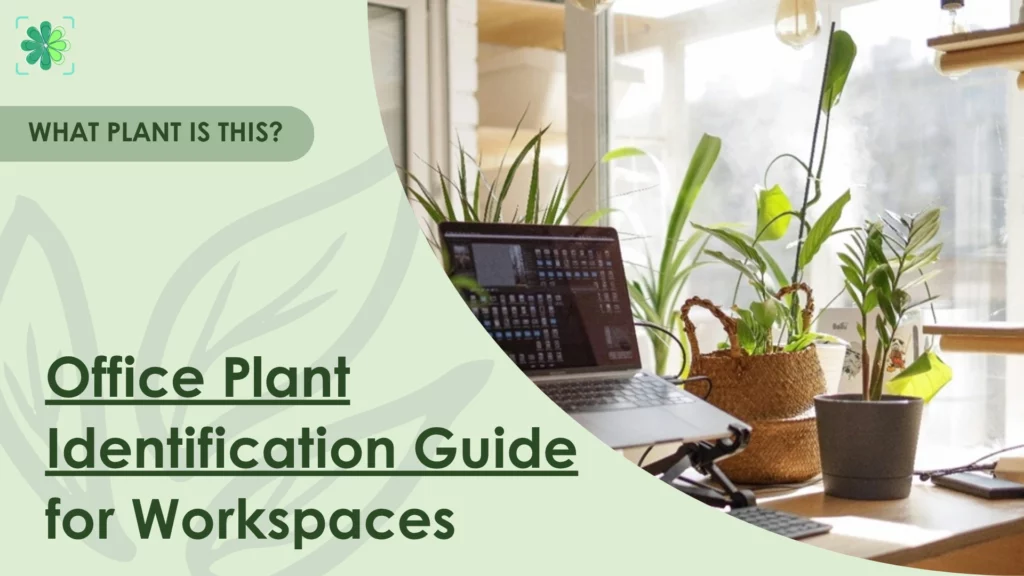
If you’re not sure what kind of plant is sitting on your desk or thriving in your coworker’s corner, this office plant identification guide is your invaluable takeaway. It covers how to recognize popular indoor species, from leafy desk plants to tall floor varieties and even green wall climbers. You’ll also learn to recognize visual clues, utilize tools to expedite identification, and receive tips on selecting the best plant for your specific light and care conditions. Let’s dive in right now!
Why Office Plant Identification Matters?
Understanding office plant identification helps you care for your greenery properly and avoid common problems. Here’s how it makes a difference:
- Prevent care mistakes like overwatering a cactus or placing a low-light plant in direct sun.
- Troubleshoot faster by spotting signs of stress, pests, or improper lighting early.
- Pick plants that fit your space, especially if your office has low light or dry air.
- Plan smarter by grouping plants with similar needs or choosing ones that thrive with little attention.
How to Identify Office Plants Like an Expert?
When identifying a plant in your office, it’s tempting to rely on a photo match, but the real key lies in observing details that apps might miss. A thoughtful approach combining visual clues, growing context, and environmental cues will make your office plant identification more accurate and insightful.
Visual Clues to Observe
Start with the leaves, since they’re often the most distinctive part. Look at their shape. Are they heart-shaped like pothos, lance-shaped like snake plants, or feathered like a parlor palm?
Don’t stop there. Check the leaf edges (smooth, toothed, lobed), the vein pattern (parallel like a peace lily or netted like a philodendron), and even the texture. A ZZ plant leaf is thick and waxy, while ferns often feel soft and papery.

Next, look at the growth habit:
- Upright, structured plants with thick stems, like the rubber tree or dracaena, often indicate a floor plant species.
- Vining or trailing types, such as pothos and ivy, are typically intended for use on shelves, in wall planters, or hanging baskets.
- Compact, slow-growing plants like the ZZ plant or snake plant make perfect desk companions due to their tidy, vertical form.
The presence or absence of flowers is also a key detail. Peace lilies, for instance, regularly produce white, hooded flowers, especially when they’re happy with their light and moisture. In contrast, some plants, like most dracaenas or philodendrons, rarely flower indoors, so the absence of blooms doesn’t always mean poor health.
Also, consider the placement of the plant. Is it tucked in a corner with no windows? Sitting under fluorescent light on a desk? Or displayed near a bright window?
The location itself offers strong clues. Plants thriving in low-light zones are likely to be species like snake plant, ZZ plant, or Chinese evergreen. Those near bright light are more likely to include rubber plants or crotons, which need that extra sun.
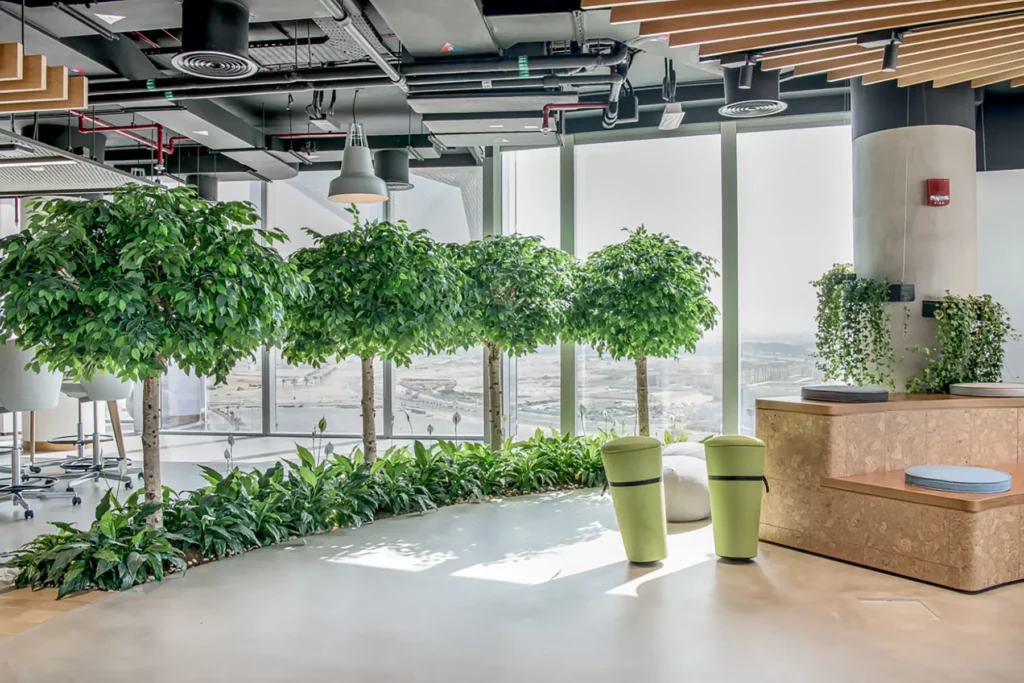
Quick-Start Tools
Tools like Planteyes are useful for office plant identification when used correctly. Make sure to take multiple photos (close-ups of the leaf, stem, and whole plant) and avoid cluttered backgrounds. Many apps also improve accuracy when you add notes like lighting conditions or plant location.
If you want to dig deeper, try using simplified plant keys or online charts. These guides walk you through step-by-step choices, such as “Are the leaves variegated?” or “Is the stem woody or soft?”, helping you eliminate options and pinpoint the correct identification. They’re invaluable for distinguishing common lookalikes, such as Chinese evergreen vs. dumb cane, or philodendron vs. pothos.
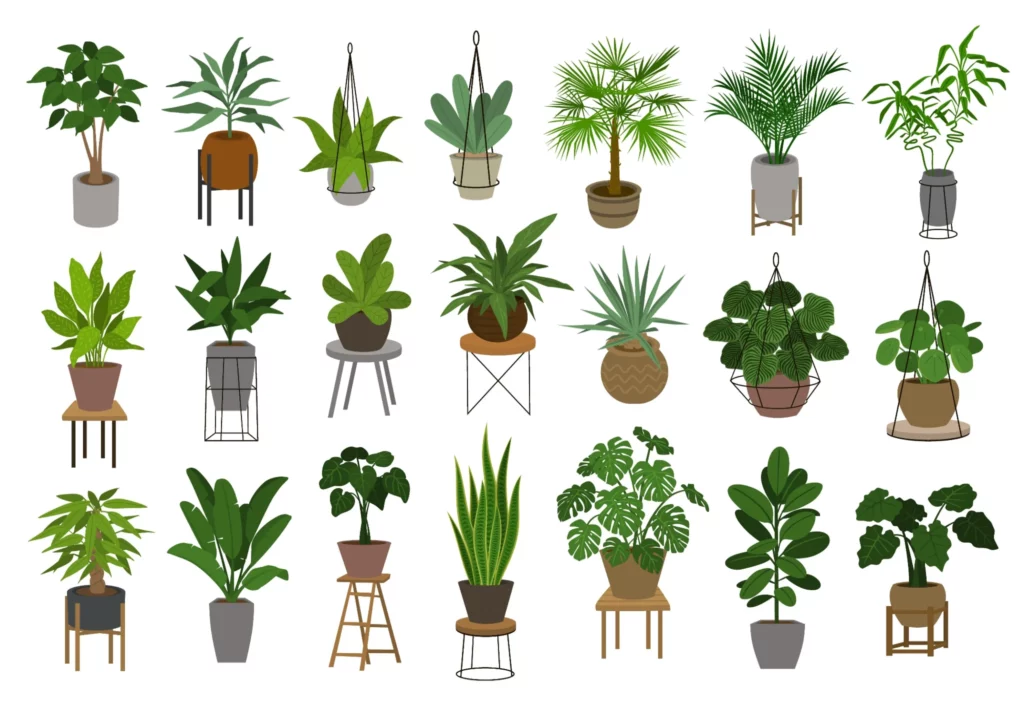
Most Common Office Plants and How to Identify Them?
Use this section as a quick-reference guide for office plant identification, especially when you need fast visual clues.
Desk-Friendly Plants (Small & Compact)
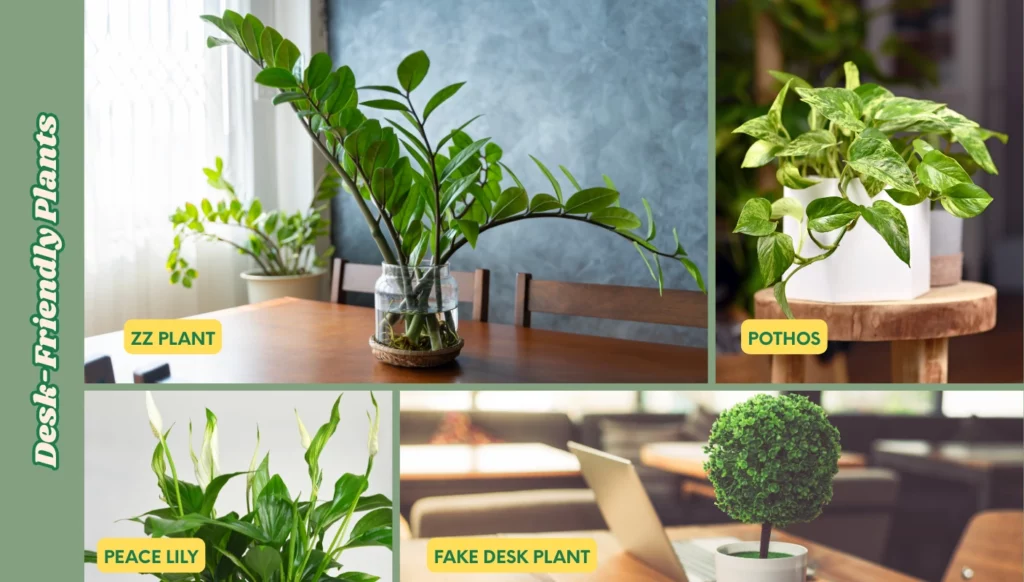
1. Pothos (Epipremnum aureum) – Heart-shaped, often variegated leaves that trail over the edge of pots or shelves. Grows quickly, even in low light and inconsistent watering. A classic go-to in office plant identification due to its forgiving nature.
2. Peace Lily (Spathiphyllum) – Dark, upright leaves with elegant white, hooded flowers. Known for drooping dramatically when thirsty—and recovering fast after watering. Common in meeting rooms or reception areas with filtered light.
3. ZZ Plant (Zamioculcas zamiifolia) – Thick, waxy leaves on upright stalks. Deep green and incredibly low-maintenance, it makes for one of the easiest choices for low-light offices. Its glossy texture often leads to confusion in office plant identification, especially next to fake plants.
4. Fake Desk Plants – Perfectly uniform leaves, rigid stems, and unmoving soil. No scent or natural imperfections. For accurate office plant identification, gently tap the leaves or look for glued-down pebbles at the base.
Office Floor Plants (Taller Varieties)
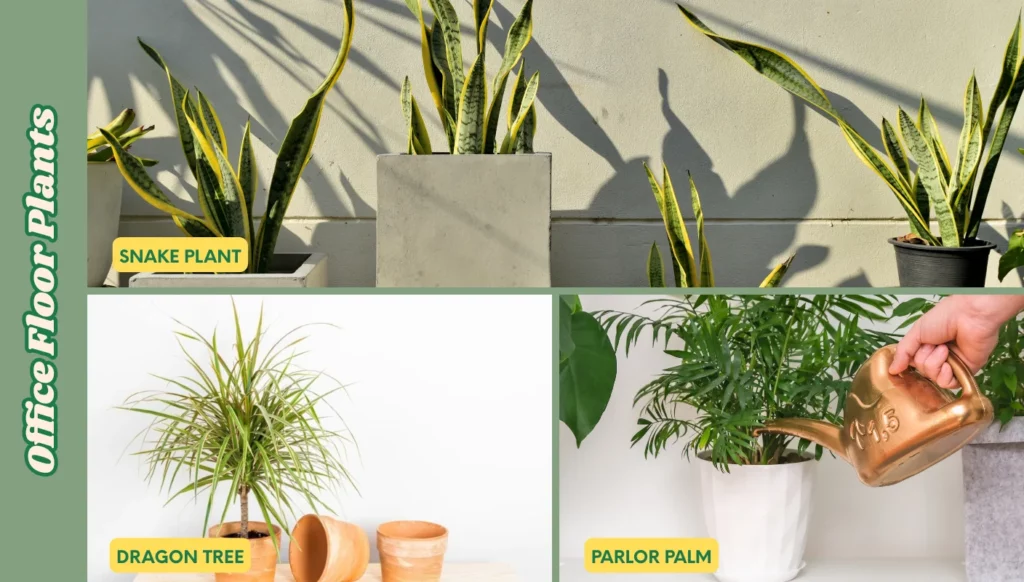
1. Snake Plant (Dracaena trifasciata) – Tall, stiff leaves that grow vertically like swords. Patterns range from green with gray stripes to yellow-edged varieties. A resilient choice that handles neglect, making it a common sight in corners or near filing cabinets.
2. Dragon Tree (Dracaena marginata) – Slender trunk with spiky tufts of long, narrow leaves on top. Some types have reddish edges. Often placed in decorative pots to create vertical interest in large open spaces.
3. Parlor Palm (Chamaedorea elegans) – Soft, feathery fronds growing in clusters. Compact and tidy, yet visually lush. It’s a popular choice for break rooms or offices with limited natural light.
Office Green Wall Candidates
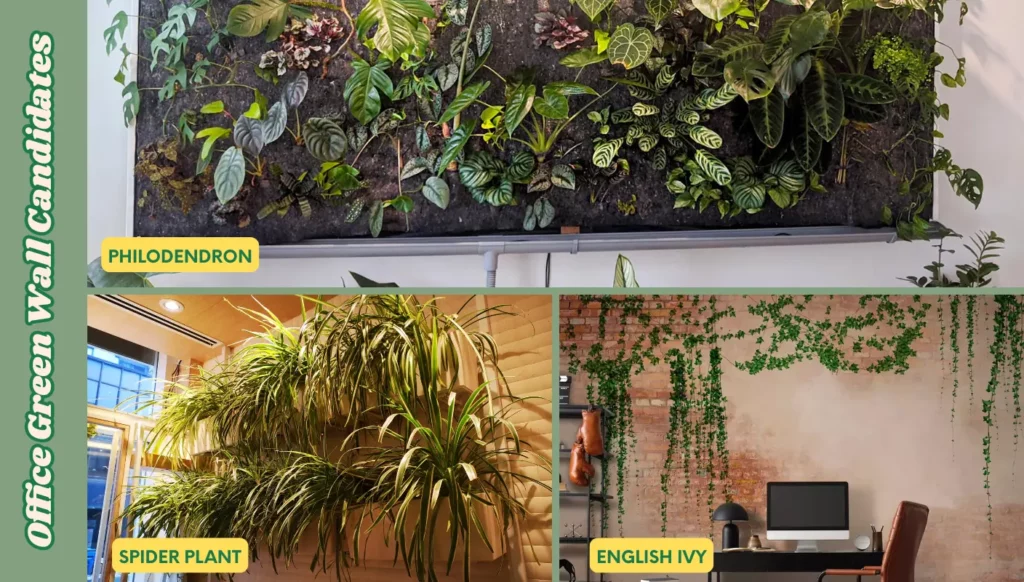
1. Philodendron (Climbing types) – Broad, matte-finished leaves on fast-growing vines. Can be trained to climb or trail, depending on setup. Often confused with pothos, but it typically has softer leaves and fewer variegations.
2. Spider Plant (Chlorophytum comosum) – Narrow arching leaves with a central white stripe, plus small “pups” that dangle from long stems. A favorite for wall-mounted planters or hanging pots. Easy to identify once you know what to look for.
3. English Ivy (Hedera helix) – Small, lobed leaves that grow densely on trailing vines. Spreads fast and adapts well to vertical structures. Often seen in decorative living walls or window sills with partial shade.
Best Plants for Office with Low Light
Some plants are surprisingly adaptable to low-light conditions, making them perfect for offices with few or no windows. Below is a shortlist of species that consistently do well under fluorescent lights or in dim spaces:
- ZZ Plant – Tolerates neglect, low light, and dry air. Great for desks or floor pots far from windows.
- Snake Plant – Stiff, upright leaves that survive under almost any lighting.
- Pothos – Trailing vine that stays green even in cubicle corners.
- Peace Lily – Prefers filtered light and signals when it needs water.
- Parlor Palm – Adds a soft, leafy texture to dim rooms without demanding much light.
Just remember: “low light” doesn’t mean no maintenance. These plants still need occasional attention. Dusty leaves, compacted soil, or lack of airflow can all affect their health, even if lighting isn’t an issue.
Also, be aware of the warning signs that your plant isn’t getting enough light:
- Legginess – Stems stretch unnaturally toward any available light source
- Pale or yellow leaves – A sign the plant isn’t photosynthesizing efficiently
- Slowed growth – Common when the plant enters light-starved survival mode
Understanding these clues helps with proper care and supports accurate office plant identification, especially when a plant’s condition gives away more than its appearance.
Choosing the Right Plant: A Quick Reference
| Office Condition | Best Plant Options | Plant Type |
| Low-light office | Snake Plant, ZZ Plant, Peace Lily | Upright, compact |
| Dry air / air-conditioned rooms | Spider Plant, Parlor Palm | Arching, leafy |
| Busy schedule (low maintenance) | Pothos, ZZ Plant, Fake Plants | Trailing or upright |
| Statement plant (floor display) | Dragon Tree, Rubber Plant | Tall, structural |
| Decorative wall use | English Ivy, Philodendron, Ferns | Climbing or cascading |
Troubleshooting: How to Identify a Struggling Plant
Noticing changes in your office plant’s appearance? The leaves, stems, and even soil can tell you what’s wrong if you know what to look for. This section helps you interpret the most common signs of stress.
1. Wilting, Browning, and Spots

- Wilting is often the first red flag. If the leaves droop and the soil is bone dry, it’s likely a sign of underwatering. But if the soil is wet and the plant still droops, overwatering is a more serious concern.
- Browning tips or crispy edges typically indicate low humidity, especially in heavily air-conditioned spaces.
- Spots or irregular patches can come from sudden temperature swings, poor water quality, or light stress.
2. Overwatering vs. Underwatering
These two problems look similar but feel very different:
- Overwatering causes yellowing, soft leaves, and wet, compacted soil.
- Underwatering leads to dry, curled leaves and very light, dusty soil.
Tip: Lift the pot. A heavy pot likely means too much water; a very light one likely needs watering.
3. When to Repot, Relocate, or Retire
- Repot if the plant has outgrown its container or if roots are circling the pot’s edge.
- Relocate if the lighting is poor or the airflow is restricted. Some plants decline simply because they’re in the wrong spot.
- Retire or replace a plant that’s been declining for months with no recovery, especially if it’s bringing pests into your workspace.
4. Common Office Plant Pests
Look out for:
- Spider mites – fine webbing, especially on leaf undersides
- Fungus gnats – tiny black flies near the soil surface
- Mealybugs – white, cottony clusters around leaf joints or stems
Spotting pests early is a key part of accurate office plant identification, since symptoms often mimic watering or light issues.
Bonus: Real vs. Fake Desk Plants
Not every office has the time, light, or staff to care for real plants, so it’s no surprise that artificial greenery is a popular alternative. Artificial plants are ideal for:
- Windowless or low-light rooms where even low-light species struggle
- Teams that don’t have the time (or interest) to water and trim regularly
- Environments where real plants might not be allowed due to allergies or regulations
They’re also budget-friendly long term: no replacement costs, no watering tools, no soil spills.
Pros and Cons of Fake Desk Plants
| Pros | Cons |
| No watering, trimming, or sunlight needed | Don’t offer real air-purifying or humidity benefits |
| Always look neat—no wilting or leaf drop | May look unnatural if poorly made |
| Free from pests, dirt, or messy soil | Collect dust and still require occasional cleaning |
How to Mix Real and Faux (Effortlessly)?
- Place real plants near natural light sources where they’ll thrive (e.g., peace lily by the window).
- Use fake plants in darker corners, high shelves, or communal spaces where maintenance is harder.
- Stick to one color scheme or texture style so fake and real plants blend seamlessly.
- Use matching pots or planters to tie everything together visually.
Final Thought
Ultimately, learning the basics of office plant identification enables you to maintain healthy plants and a visually appealing space. Once you know what you’re caring for, everything from watering to placement becomes easier. Try the Planteyes app to identify plants around your workspace quickly.
FAQs
How can I identify an office plant if I don’t know its name?
Take clear photos of the leaves, stem, and overall plant shape, then use a plant ID app like Planteyes. For better accuracy, include notes on lighting, watering habits, and location (e.g., on a desk or near a window).
What are the most common plants found in office settings?
The most common are ZZ Plant, Snake Plant, Peace Lily, Pothos, and Spider Plant. These are chosen for their ability to handle low light, dry air, and occasional neglect.
Which office plants survive best without natural sunlight?
Top picks include ZZ Plant, Snake Plant, Peace Lily, and Parlor Palm. These can thrive under fluorescent lights and tolerate windowless rooms with minimal care.
What are some truly low-maintenance plants I can keep in my office?
ZZ Plant, Snake Plant, and Pothos are all excellent low-maintenance options. They tolerate missed waterings, low humidity, and inconsistent lighting, making them ideal for busy office environments.


